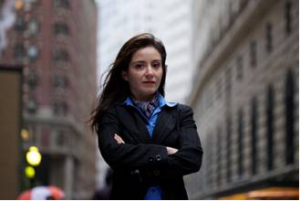Whistleblower Spotlight -- New York Fed Whistleblower Carmen Segarra

Source: ProPublica
By the C|C Whistleblower Lawyer Team
This week’s “Whistleblower Spotlight” falls on former New York Federal Reserve Bank examiner Carmen Segarra. She is the individual the New York Fed fired in 2012 for refusing to back off her charges that Goldman Sachs was engaging in serious conflicts of interest. She also is the whistleblower who has been at the center of a media storm over recent revelations that she secretly recorded 46 hours of meetings and conversations inside the Fed relating to how the banking regulator was going to deal with Goldman’s reported transgressions. According to an in-depth report on ProPublica, which also contains excerpts from the recordings, the secret tapings “offer an intimate study of the New York Fed’s culture at a pivotal moment in its effort to become a more forceful financial supervisor.”
Segarra is an ivy-league trained expert in legal and regulatory compliance with previous stints at Citigroup, MBNA and the French bank Société Générale. The New York Fed hired her in late 2011 as part of a wave of new examiners the Fed brought in to strengthen its regulatory oversight of large banks in line with the Fed’s beefed-up responsibilities and authority under Dodd-Frank. She was directed to focus particular attention on Goldman’s conflict of interest policies because of the bank’s history of pushing the envelope in this area. According to an earlier ProPublica report on Segarra, an oft-told joke on Wall Street about Goldman’s approach to business is “if you have a conflict, we have an interest.” So Segarra went digging, but apparently her superiors at the Fed were not comfortable with what she found.
Segarra found that Goldman had serious lapses in its conflicts of interest controls. She went so far as to conclude the company had no real controls at all and should be the subject of an enforcement proceeding and sanctions. But before she could finalize her findings, her supervisors pressured her to change them. She refused, arguing her findings were correct and there was too much incriminating evidence for her to back off. The Fed fired her for her intransigence — only seven months after she got there — claiming it had lost confidence in her ability to follow directions and not jump to conclusions. From Segarra’s viewpoint, “they wanted me to falsify my findings, and when I wouldn’t, they fired me.” In October 2013, she sued the Fed for wrongful termination. Earlier this year, a judge dismissed her case without ruling on the merits, concluding the facts did not fit the statute under which she sued. She is appealing the decision.
The Fed of course disputes its firing of Segarra had anything to do with her refusal to go soft on Goldman. It claims its decision to terminate Segarra “was based entirely on performance grounds.” Which makes what is revealed in the tapes all the more important in getting to the bottom of what is really going on at the Fed. As ProPublica sees it, Segarra’s recordings “make clear that some of the cultural obstacles” there which historically have made the Fed too deferential to banks persist. In its report on the secret tapes, the Guardian goes one step further, arguing they reveal “a culture of fear and servility when dealing with the very banks they were supposed to be regulating . . . — a supine watchdog willfully baring its gums before a known burglar so that he may go about his business unperturbed.”
Whatever comes from this, it would appear the New York Fed has a ways to go in stepping up its enforcement prowess and casting off the perception it is too cozy with the Wall Street banks it is supposed to police. Afterall, Segarra’s hiring directly followed from a detailed independent investigation conducted by Columbia University finance professor David Beim which unequivocally found the Fed “too risk adverse and deferential to the banks it supervised.” Part of his recommended fix was to hire examiners just like Segarra “who would be contrarian, ask difficult questions and challenge the prevailing orthodoxy.” Segarra seems to have kept up her end of the bargain, paying a very dear price for it. Hopefully, the tapes will bear out what really went down and Segarra’s efforts to rattle the Fed into action will not have been in vain.
Tagged in: Whistleblower Spotlight and Interviews,